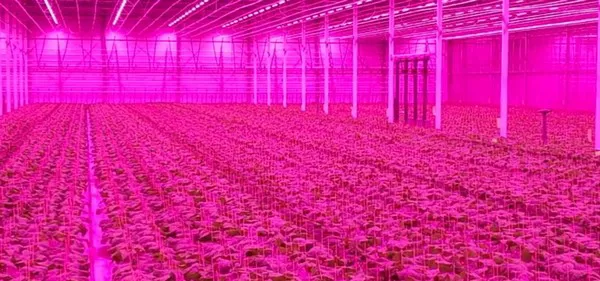Nowadays, LED lights are installed in the greenhouse of German vegetable plant propagator Achim Gernert of Jungpflanzen Gernert. That is nothing special so far, but the choice for full 100% LED in the nursery is. As far as specialists know, he is the first person in the world to opt for this in his new 2-hectare greenhouse, which was built in 2019.

More light
During the International Propagation Seminar held this autumn, Achim and his crop consultant Hans van Herk of Propagation Solutions talked about their experiences with the lighting supplied by Signify.
In his other older greenhouse, Achim was using HPS lighting, but with 50 to 60 micromol. He did not think this was enough, so he wanted more, without raising electricity costs as electricity is expensive in Germany. At first, 80 micromol was considered, but the light distribution in the greenhouse turned out to be suboptimal. The decision was made to go for 100 micromol.
Good growth
In a video, the plant propagator shows his satisfaction with the 100 micromol LED lighting. He sees nothing but growing advantages in tomatoes and it also works well in the cucumber crops until mid-February, then the influence of LED decreases as daylight increases in that growing period. In any case, the grower gives the young plants less light in the beginning, about 12 to 13 hours, after which he increases this. For tomatoes, this is a maximum of 18 hours, for cucumber a maximum of 20 hours, and for bell pepper 14 to 15 hours.
Energy saving
Another important advantage of full LED is energy saving, although the investment costs are still considerably higher than for HPS. This is also the reason why the grower, despite being satisfied, has not converted his other 1.8 hectare greenhouse with HPS to full LED as well. But when the lights are running the costs are considerably lower compared to the used standard. Therefore, he has opted for a hybrid solution in the older greenhouse.
Fine-tuning
Before this greenhouse may also switch to full LED in the future (rising energy costs may help with this decision), Achim and Hans are still looking for a more optimal distance between the first and second trusses. This is where the grower, who expects to learn a lot about growing under LED in the next two to three years if nothing else, sees specific steps to be taken. Hans explains: "The number of leaves between the trusses is generally three. However, in the case of plants that have been pinched up on the second leaf, it can sometimes be four or five. This is not optimal for the grower and can be influenced by temperature, light, and planting distance. We still have to find the optimal form in this. Because LED does not provide extra heat like HPS, this will have to be resolved in a different way."
For more information:
International Propagation Seminar
www.internationalpropagationseminar.com
